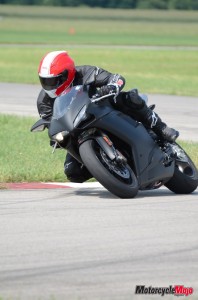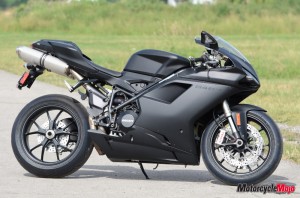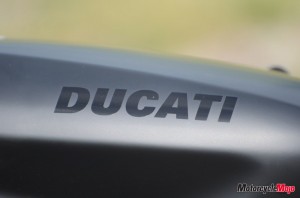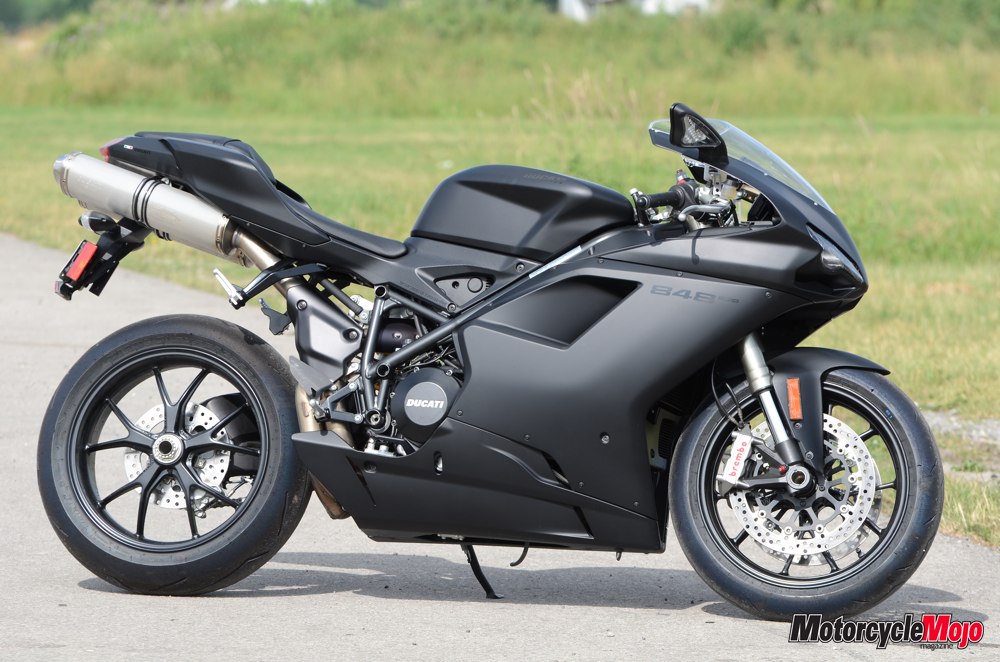Black Moon Rising
Ducati, like many of its compatriot motorcycle manufacturers, seems to have an unwritten manifesto dictating that every sportbike must look as good as it is to ride. Ducatis are therefore typically finished in bold, attention-seeking colours – they are the peacocks of the motorcycle world. Or so I thought.
Finished in Dark Stealth paint, the Ducati 848 EVO offers buyers an alternative – it shuns extroverted skins in favour of flying under the radar of public scrutiny and getting on with the business of being a high-performance machine. And although I initially admired the menacing appearance of the machine and appreciated its ability to lurk in the shadows, I quickly became dismayed by how the matte black paint job was terribly disfigured by everything that it came in contact with. Whether it was fingerprints or bug impacts, this motorcycle isn’t easy to keep clean.
 Paint choices aside, the 848 EVO has all the traditional Ducati trademarks: A single-sided swingarm, trellis frame, an underseat exhaust, majestically sculpted bodywork, and on this particular model, five-spoke Enkei wheels. Virtually identical in appearance to the 848, which was first introduced in 2008, you have to look under its skin for what makes this an updated model. The EVO designation came from the Testastretta Evoluzione engine powering the machine, which has been deeply massaged to produce an additional six horsepower (now claimed to peak at 103 kW or 140 hp) and an improved torque output of 98 N-m (72.3 ft-lb).
Paint choices aside, the 848 EVO has all the traditional Ducati trademarks: A single-sided swingarm, trellis frame, an underseat exhaust, majestically sculpted bodywork, and on this particular model, five-spoke Enkei wheels. Virtually identical in appearance to the 848, which was first introduced in 2008, you have to look under its skin for what makes this an updated model. The EVO designation came from the Testastretta Evoluzione engine powering the machine, which has been deeply massaged to produce an additional six horsepower (now claimed to peak at 103 kW or 140 hp) and an improved torque output of 98 N-m (72.3 ft-lb).
The performance gains from the liquid-cooled, 90-degree L-twin were achieved in part by revising its inlet ports and enlarging its elliptical throttle bodies. Inside the engine, Ducati changed its piston crown profiles and reshaped the combustion chambers to increase compression from 12:1 to 13.2:1. Revised camshafts were also used, designed to increase valve lift and inlet duration, an advancement that Ducati claims was only made possible by the characteristics of their Desmodromic valve system.
In practice, the EVO engine is a charm. For a twin, it builds revs quickly and likes to spin at high revs, two qualities that punctuated the importance of its rev limiter and strobe-like shift lights as I acquainted myself with the machine. More noticeable than the engine’s increased power was its improved torque, which gave the 848 EVO an edge on the track over inline -four powered 600s, especially when accelerating from mid-revs when engine speed wasn’t maintained through a turn.
The improved performance hasn’t come at the cost of reliability. In an effort to make their motorcycles more affordable to maintain, Ducati has set the service intervals for the 848 EVO at every 12,000 km.
The EVO’s chassis is also typical Ducati. The tubular steel trellis frame developed alongside Ducati’s racing division features a magnesium subframe for the front end and contributes to making this motorcycle, at a dry weight of 168 kg (370 lb.), the lightest superbike Ducati has ever mass produced. Despite being burdened by my substantial weight and the stresses of being thrown through successive opposing turns, the frame felt as rigid as an I-beam and kept the bike pointed where it was aimed.
 Further contributing to the exemplary handling was the single-sided swingarm that combines aluminum castings in high-stress areas such as the wheel hub, pivot points and suspension with lightweight, fabricated-aluminum sections. A linked, fully adjustable Showa shock controls the swingarm’s arc, while at the front of the bike, a fully adjustable 43 mm Showa inverted fork keeps the front wheel planted. A steering damper helps maintain front-end stability.
Further contributing to the exemplary handling was the single-sided swingarm that combines aluminum castings in high-stress areas such as the wheel hub, pivot points and suspension with lightweight, fabricated-aluminum sections. A linked, fully adjustable Showa shock controls the swingarm’s arc, while at the front of the bike, a fully adjustable 43 mm Showa inverted fork keeps the front wheel planted. A steering damper helps maintain front-end stability.
Despite relying on its stock settings, I was impressed with the suspension’s performance, especially over the rough sections of the track, which are notorious for causing front ends to wash out. However, part of the credit for the machine’s handling prowess should go to its nimble weight and the Pirelli Diablo Supercorsa SC1 tires fitted to it.
The motorcycle’s race-derived Brembo Monobloc front brakes squeeze 320 mm discs and proved to be very powerful; it only took modest lever pressure before I had to clamp the fuel tank with my legs. The frequent and constant late braking for tight turns did nothing to diminish the brakes’ potency at slowing the EVO in short distances from high speeds.
With an ever-increasing number of sportbikes being fitted with complex electronics packages, it was surprising to discover that the 848 EVO lacked traction control and ABS. The traction control wasn’t missed given the engine’s smooth power delivery, but not having a race ABS system was a disappointment.
 Inspired by the displays used on their MotoGP prototypes, the EVO’s entirely digital dash displays myriad data, controlled via a toggle switch mounted on the left handlebar. The system was easy to navigate without the aid of an owner’s manual, though it might not seem as intuitive to those lacking experience with other Ducati models. The instrument panel is also capable of working with the optional Ducati Data Analyser (DDA) system, which compiles information from the bike’s various ECU channels, including throttle openings, road speed, engine rpm, gear selection, engine temperature, distance travelled, lap numbers and times. It was inexplicable, then, that the display didn’t offer a basic fuel gauge; in its place was a low-fuel trip meter and warning light system.
Inspired by the displays used on their MotoGP prototypes, the EVO’s entirely digital dash displays myriad data, controlled via a toggle switch mounted on the left handlebar. The system was easy to navigate without the aid of an owner’s manual, though it might not seem as intuitive to those lacking experience with other Ducati models. The instrument panel is also capable of working with the optional Ducati Data Analyser (DDA) system, which compiles information from the bike’s various ECU channels, including throttle openings, road speed, engine rpm, gear selection, engine temperature, distance travelled, lap numbers and times. It was inexplicable, then, that the display didn’t offer a basic fuel gauge; in its place was a low-fuel trip meter and warning light system.
There’s little point in harping about the ergonomic design of a motorcycle that is truly only in its element on a closed road course. On the street, the typical sportbike caveats applied: sore wrists, neck and buttocks are what you can expect, all the more if you’re a man of normal scale and advancing years. The bike’s fit on the track was another matter, and in such an environment it not only works well, but it begins to make perfect sense. What didn’t make any sense was that the fairing will slice into the back of your hands should you turn the handlebar to full lock in either direction.
With a $15,495 price tag, the 848 EVO is a few thousand more than a Japanese 600 cc sportbike – $500 more than even most 1000 cc superbikes – but its premium pricing is unlikely to deter anyone interested in the dark Ducati. Its extra cost not only buys you a modicum of exclusivity, it also rewards with a ride experience that is quite unlike anything a Japanese sportbike can offer.










